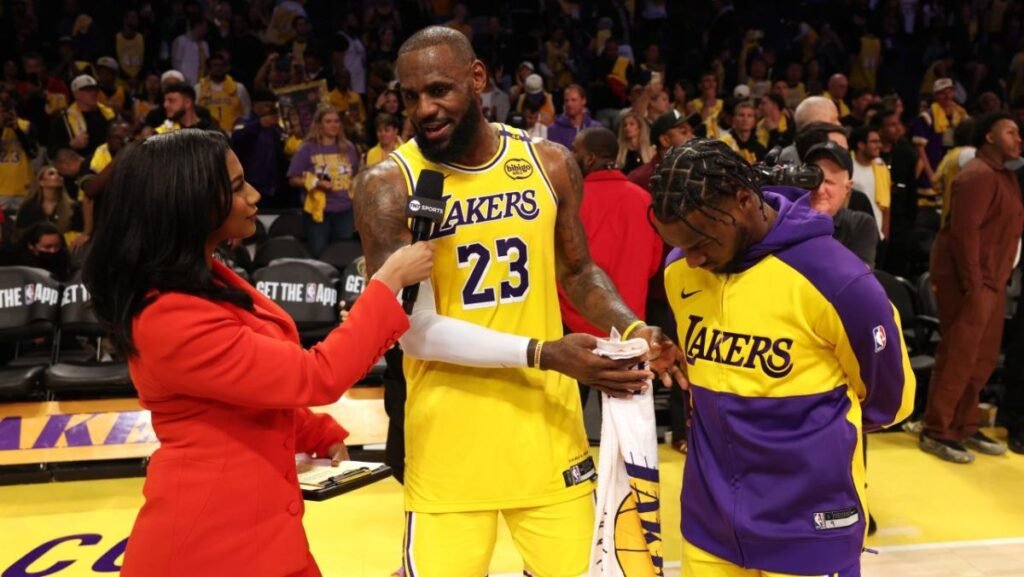Although talk of the impending loss of TNT’s NBA rights package was largely sidelined during Warner Bros.’ third-quarter earnings call. Discovery on Thursday, the results at the cable network segments went a long way to underline why the connection was such a crucial part. of the company’s programming strategy.
WBD’s global TV division generated $1.49 billion in ad revenue during the quarter, which marked a 13% year-over-year drop as domestic sales fell 21%. And while the third-quarter declines can be chalked up to a soft state advertising market, the contrast with the April-June quarter results perhaps best demonstrates the value of the NBA property.
During the second quarter, when TNT televised 42 NBA postseason games — a slate that included the five nights of the Western Conference Finals — WBD earned $2.21 billion in ad revenue, or $724 million more than it earned in the subsequent, non-NBA quarter. . .
The same dynamic occurred a year ago, as WBD took out $2.45 billion in ad sales during its big NBA finals quarter, a haul that eclipsed the following July-September period by $739 million. While it probably won’t come as a surprise that the period that coincides with the NBA’s playoff push is always WBD’s strongest ad-sales quarter, that annual bonanza will dry up after next year, when Comcast’s NBC Sports pulls out TNT from the arena. .
At the same time, the demise of WBD’s longstanding relationship with the NBA will save the company a bundle on rights fees. Under the terms of its legacy contract, WBD will pay the league more than $1.2 billion to carry its final season of professional rings.
Last month, NBA commissioner Adam Silver suggested that the lack of a “long-term relationship with the people currently running Warner Bros. Discovery” may have contributed to the dissolution of the partnership. In other words, things might have gone in a completely different direction if former Turner Sports boss David Levy, who fostered a long and mutually rewarding alliance with Silver and his predecessor David Stern in his three decades at the company, hadn’t taken flight. the cooperative following AT&T’s acquisition of Time Warner in 2019.
Wall Street analysts largely left any talk of the NBA on the bench during the call, but when asked how the league’s impending defection could affect WBD’s upcoming carriage negotiations with Comcast’s pay-TV division, CEO David Zaslav seemed confident that his a company will be able to hold its own during those negotiations. “We’re not talking about time or really about specific agreements, but [Comcast chairman and CEO] Brian [Roberts] and I have been in business together for almost 40 years,” Zaslav said. “We made all kinds of deals… to create value for both companies. … [and] I look forward to doing many more things together in the future.”
Many analysts believe Roberts will look to pressure Zaslav on WBD’s affiliate rates when the company’s transportation deal with Comcast comes up for renewal late next year. In the absence of six months of NBA programming, WBD may struggle to justify the high rates it charges operators to carry its signals; TNT alone boasts a fee of $3 per sub per month, which adds up to approximately $2.43 billion in passive annual income. (As a caveat, many of these Wall Street projections appear to be based on painting Roberts as an almost cartoonish Machiavellian figure, an assessment that doesn’t quite match up with observable reality.)
While WBD recorded a breach of contract lawsuit against the NBA, in which it claims to be unfair pushed aside of newcomer Amazon Prime, that legal wrangling is unlikely to have a material impact on the league’s media partnerships after TNT’s final season ends this spring. Under the terms of Amazon’s 81-page contract with the NBA, the streamer/online retailer will begin carrying at least 60 regular-season games starting in October 2025, as well as a generous allocation of playoff games.
In total, the NBA will extract approximately $75.9 billion from rights holders Disney, Comcast and Amazon during the 11-year deal, which will run through the 2035-36 campaign.
WBD’s networks unit saw revenue improve 3% during the quarter to $5.01 billion, although the state business faced non-major headwinds. Distribution revenue fell 7% to $2.6 billion, driven by a 9% drop in domestic linear pay-TV subscribers, a loss that was partially offset by a 5% gain in US affiliate rates. Advertising revenue fell 13% to $1.49 billion, which marked a loss of $219 million from the year-ago period, as home TV ratings fell 21%.
At the direct-to-consumer unit, revenue increased 8% to $2.63 billion, as the streaming platform Max added a record 7.2 million customers, bringing its global undercount to 110.5 million. The US market accounted for 52.6 million of those subscribers, with WBD commanding an ARPU of $11.99. (By comparison, Max’s international subscriptions generated an average return per user of $4.05.)
